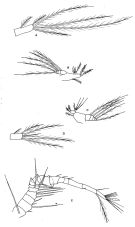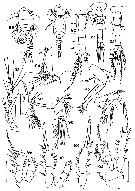|
|
 |
Fiche d'espèce de Copépode |
|
|
Cyclopoida ( Ordre ) |
|
|
|
Oithonidae ( Famille ) |
|
|
|
Oithona ( Genre ) |
|
|
| |
Oithona dissimilis Lindberg, 1940 (F,M) | |
| | | | | | | Syn.: | Oithona dissimilis oceanica Lindberg, 1947;
O. hebes : Wellershaus, 1969 (p.276, figs.F,M) | | | | Ref.: | | | Lindberg, 1940 (p.519, Descr.F,M, figs.F); Sewell, 1948 (p.430); Lindberg, 1955 a (p.467: Rem.); Gonzalez & Bowman, 1965 (p.270, Rem.); Ferrari, 1977 (p.400, Redescr., figs.F, M, Rem.); Ueda, 1985 (p.125); Nishida, 1985 (p.138, 141); 1985 a (p.142, 143); Chihara & Murano, 1997 (p.937, Pl.198,202: F,M); McKinnon, 2000 (p.108, Rem.); Cornils & Heckmann, 2015 (p.243, Fig. 2, molecular biology) |  issued from : F.D. Ferrari in Proc. Biol. Soc. Washington, 1977, 90 (2). [p.401, Fig.1]. From Tutuila Island, American Samoa. Female: A, habitus (lateral left side); B, idem (dorsal); C, urosome (ventrolateral left side). Nota: Metasome segments 1-4 each with a pair of dorsal sensory hairs, (segmet 2 with 2 pairs). Excluding terminal spine, exopod of P1-P4 with 1-1-3, 1-1-3, 1-1-3, 1-1-2 external spines, respectively; 1-1-4, 1-1-5, 1-1-5, 1-1-5 internal setae, respectively. Endopod P1-P4 with 0-0-1, 0-0-1, 0-0-1, 0-0-1 external setae, respectively and 1-1-5, 1-2-5, 1-2-5, 1-2-4 internal setae, respectively. Male: D, habitus (dorsal); E, idem (ventrolateral right side); F, detail of cephalosome (ventrolateral); G, urosome (ventrolateral left side). Nota: Prosome laterally with a very complex group of integumental organs in an area comprising posteroventral part of cephalosome and posterior extension or flap of cephalosome overlapping following segment.
|
 issued from : F.D. Ferrari in Proc. Biol. Soc. Washington, 1977, 90 (2). [p.403, Fig.2]. From Tutuila Island, American Samoa. Female: A, caudal ramus (ventral); B, Md. Male: C, Md; D, caudal ramus (ventral); E, A1.
|
 issued from : F.D. Ferrari in Proc. Biol. Soc. Washington, 1977, 90 (2). [p.405, Fig.3]. From Tutuila Island, American Samoa. Female: A, Mx2; B, P4 (anterior). Nota: Three large spines of Mx2 with notch on 2/3 dorsal margin.
|
 Issued from : S. Wellershaus in Veröff. Inst. Meeresforsch. Bremerh., 1969, 11 (2). [p.277, Fig.88-102]. As Oithona hebes. Female (from Cochin Backwater, S. India): 88, habitus with ovisacs (dorsal); 90, urosome (ventral); 93, A1 (one terminal seta deformed); 96, A2; 97, Md; 99, P1; 100, P2; 101, exopod of P3; 102, P4 (in endopod onlly the specialized setae fully drawn). Male: 89, habitus (dorsal); 91, urosome (dorsal); 92, urosome (juvenil; dorsal); 94, A1 (sheath not dotted; n = notch; aesthetasc on the end); 95, A2; 98, Md.
Scale : single line = 0.1 mm ; double line = 0.05 mm. Nota Female: - Eye blue. - 5th thoracic segment without hairs on the posterior margin. - Caudal rami longer than the 5th thoracic segment; length: breadth = 2.50-2.88. - Proportions of the urosomal segments 12, 33, 14, 14, 13; caudal rami 14 %. - Proportions (%) of the caudal setae Se = 7.5; St4 = 9.5; St3 = 30; St2 = 44; St1 = 20; Si (dorsal) = 26. - P4: ratio exopodal segment 3 terminal spine: whole length of exopod = 86 : 109; endopod : exopod = 67 : 109. - P5 bears a fine seta which is directly dorsally, and 1 terminal seta. No ciliation was observed on either of these P5 setae. The terminal seta reaches almost the end of abdominal segment 1-2. - Two egg sacks contain about 15 eggs each. Nota Male: - A1 twice geniculated; the proximal geniculation is surrounded by a sheath; distal geniculation with a notch in the segment. - Caudal rami shorter than in female; Si very short and can only be seen (with difficulty). - Proportions of the urosomal segments pus caudal rami: 19 : 19 : 16 : 13 : 10 :11 : 13. - Proportions (%) of the urosome 19 (5th thoracic segment) : 19 (1st abdominal segment) : 16 : 13 : 10 : 11 : 13 (caudal rami).
|
 issued from : K. Lindberg in Rec. Indian Mus., 1940, 42 (2). [p.520, Fig.2]. Female (from Oupalom pond, Pondichery): a, anal segment and caudal rami (dorsal); b, 5th thoracic segment and genital segment (ventral); c, A1; d, A2; e, endopod of P4; f, forehead (ventral). Nota: Ratio lenths cephalothorax: urosome1.17-1.66:1. Forehead without rostrum, as a bilobated mass ventrally. Genital segment slightly longer than the posterior two segments combined; 2nd to 4th abdominal segments following from length slightly equal. Caudal rami strongly diverging, inner margin without hairs. A1 16-segmented, but sutures between 8th and 9th segments, and 13th and 14th more or less distinct, reaching the middle or posterior margin of the 4th thoracic segment. Exopod 3 of P4 about 2 times the length of the endopod 3. Ovisacs large, comprising each 10 to 22 eggs.
|
 issued from : K. Lindberg in Rec. Indian Mus., 1940, 42 (2). [p.522]. Dimensions from two females I and II. Longueur = length; Largeur = wide; queue = urosome ; externe = outer; interne = inner; mediane = medial. Soie = seta; Furca = Caudal rami; Cinquième patte = P5.
|
 Issued from : S. Wellershaus in Veröff. Inst. Meeresforsch. Bremerh., 1969, 11 (2). [p.278]. As Oithona hebes. Armature of swimming legs P1 to P4. with marginal spines (I-III) and setae (1-4). Re = exopod; Ri = endopod.
| | | | | Ref. compl.: | | | Ueda, 2001 (p.96, occurrence); Lo & al., 2004 (p.468, tab.2); Ohtsuka & al., 2008 (p.115, Table 5); Maiphae & Sa-ardrit, 2011 (p.641, Table 2, 3, Rem.); Saitoh & al., 2011 (p.85, Table 4, 5); Chew & Chong, 2011 (p.127, Table 2, 3, abundance vs location); Ueda & al., 2011 (p.2069, size vs salinity, speciation); Zamora Terol, 2013 (p.164: Table 3, prosome length, body weight, egg production); Ohtsuka & Nishida, 2017 (p.565, 578, Table 22.1); | | | | NZ: | 4 | | |
|
Carte de distribution de Oithona dissimilis par zones géographiques
|
| | | | | | | | |  Issued from : S. Nishida in Bull. Ocean Res. Inst., Univ. Tokyo, 1985, No 20. [p.143, Fig.94]. Issued from : S. Nishida in Bull. Ocean Res. Inst., Univ. Tokyo, 1985, No 20. [p.143, Fig.94].
Indo-Pacific gepgraphical distribution of Oithona dissimilis. |
 Issued from : S. Zamora Terol in Tesis Doc. Univ. Politèc. Catalunya, 2013 [p.163, Table 2]. Issued from : S. Zamora Terol in Tesis Doc. Univ. Politèc. Catalunya, 2013 [p.163, Table 2].
Feeding experiments in the mangrove area of Townsville (Northeastern Australia). The initial prey concentration (in cells and biomass), clearance rates (mL female-1 day-1), and ingestion rates (in cells and % body carbon ingested.
Asterisks (*) indicates significant feeding rates.
See Oithona attenuata. |
 Issued from : S. Zamora Terol in Tesis Doc. Univ. Politèc. Catalunya, 2013 [p.165, Table 3]. Issued from : S. Zamora Terol in Tesis Doc. Univ. Politèc. Catalunya, 2013 [p.165, Table 3].
Fecondity experiments in the Whitsunday Islands area (Great Barrier Reef lagoon, Northeastern Australia).
Prosome length (PL, -1). The egg production efficiency (GGE %).
See Oithona attenuata. |
| | | | Loc: | | | India (Pondichery, Cochin), Straits of Malacca (upper and lower Sangga estuary), G. of Thailand, China Seas (East China Sea), Taiwan (Tapong Bay), Okinawa (Kabira Bay, lagoons), Nansei Islands, Japan, Samoa Is., Palau Is. | | | | N: | 11 | | | | Lg.: | | | (172) F: 0,61-0,67; M: 0,58; (279) F: 0,650-0,579; M: 0,57; (635) F: 0,7-0,61; M: 0,72-0,64; {F: 0,58-0,70; M: 0,57-0,72} | | | | Rem.: | brackish, estuaires, côtière.
Voir aussi les remarques en anglais | | | Dernière mise à jour : 01/10/2020 | |
|
|
 Toute utilisation de ce site pour une publication sera mentionnée avec la référence suivante : Toute utilisation de ce site pour une publication sera mentionnée avec la référence suivante :
Razouls C., Desreumaux N., Kouwenberg J. et de Bovée F., 2005-2025. - Biodiversité des Copépodes planctoniques marins (morphologie, répartition géographique et données biologiques). Sorbonne Université, CNRS. Disponible sur http://copepodes.obs-banyuls.fr [Accédé le 22 octobre 2025] © copyright 2005-2025 Sorbonne Université, CNRS
|
|
 |
 |










